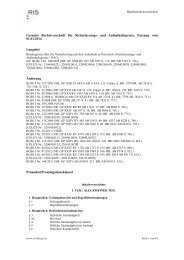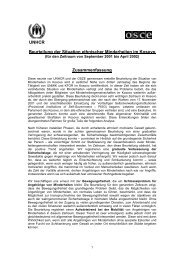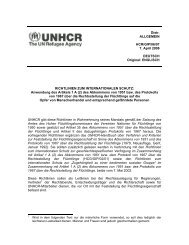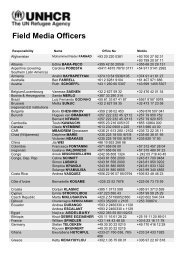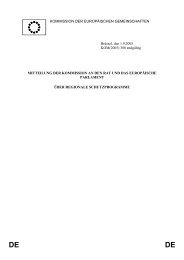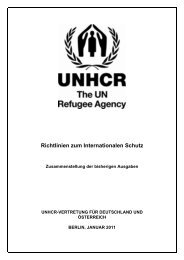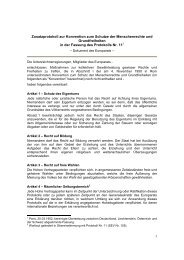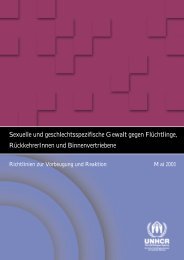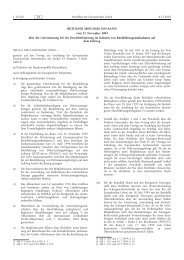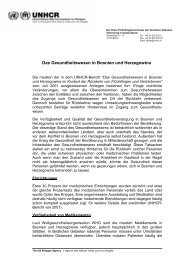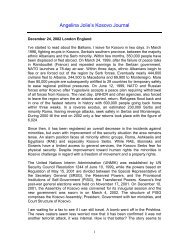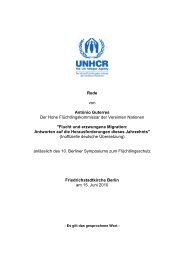EMBARGOED UNTIL MONDAY, 20 June 2011 0001 GMT ... - UNHCR
EMBARGOED UNTIL MONDAY, 20 June 2011 0001 GMT ... - UNHCR
EMBARGOED UNTIL MONDAY, 20 June 2011 0001 GMT ... - UNHCR
- No tags were found...
Create successful ePaper yourself
Turn your PDF publications into a flip-book with our unique Google optimized e-Paper software.
Some 355,900 claims were rejectedon substantive grounds. This numberincludes negative decisions at the firstinstance which might be appealed.Asylum-seekers who were rejected atfirst and second instance may have beencounted twice in this figure.Total Recognition RateAt the global level (<strong>UNHCR</strong> and Stateasylum procedures combined), the RefugeeRecognition Rate (RRR) amountedto an estimated 30 per cent of all substantivedecisions taken during <strong>20</strong>10, whilethe Total Recognition Rate (TRR) was39 per cent. (34) Both values are below therates in <strong>20</strong>09 (38 per cent for RRR and47 per cent for TRR). However, at thistime global recognition rates are indicativeas some States have not yet reportedthe relevant data. Also, the proportion ofpositive decisions is in reality higher asdecisions for those rejected on appeal areoften counted twice.Among the main receiving industrializedcountries, Switzerland and Finlandhad the highest TRR at the firstinstance in <strong>20</strong>10 (73% and 61%, respectively).Among the main countries oforigin of asylum-seekers in <strong>20</strong>10, thoseoriginating from Eritrea, Myanmarand Somalia had TRRs of over 80 percent at the first instance. Recognitionrates were also high for asylum-seekersfrom the Democratic Republic of theCongo (66%), Iraq (65%), Colombia (64%),Ethiopia (58%), Afghanistan (53%), andthe Islamic Republic of Iran (51%).By the end of the year, more than837,500 individuals around the worldwere still awaiting a decision on theirasylum claim. This figure includespeople at any level of the asylum procedure;the real magnitude of undecidedasylum cases is unknown as manycountries were not able to report thisinformation. •34 In the absence of an internationally agreedmethodology for calculating recognition rates, <strong>UNHCR</strong>uses two rates to compute the proportion of refugee claimsaccepted during the year. The Refugee Recognition Ratedivides the number of asylum-seekers granted Conventionrefugee status by the total number of substantive decisions(Convention status, complementary protection, and rejectedcases).The Total Recognition Rate divides the number ofasylum-seekers granted Convention refugee status andcomplementary form of protection by the total number ofsubstantive decisions (Convention status, complementaryprotection, and rejected cases). Non-substantive decisionsare, to the extent possible, excluded from both calculations.For the purpose of global comparability, <strong>UNHCR</strong> only usesthese two recognition rates and does not report nationallycalculated rates.VIIStatelessPersonsIdentifying statelesspersons remainedkey to addressingtheir problems andto discharging theresponsibility entrustedto <strong>UNHCR</strong> in regardto this population. Thisresponsibility is notlimited to the preventionand reduction ofstatelessness andthe protection ofstateless persons, butalso involves raisingawareness amongthe internationalcommunity of themagnitude of thisproblem. Measuringstatelessness iscomplicated by thevery nature of thephenomenon. Statelesspeople often live in aprecarious situationon the margins ofsociety, frequently lackidentity documentationand are subject todiscrimination.<strong>UNHCR</strong> / S. KritsanavarinOnly a MINORITy ofcountries have proceduresin place for the identification,registration anddocumentation of statelesspersons, which facilitates gatheringprecise data. The statistics in this reporttherefore only include data on countriesfor which reliable official statistics or estimatesof stateless populations are available.Annex Table 7 also includes somecountries (marked with an asterisk) thathad significant stateless populations butfor which no reliable figures were provided,including Côte d’Ivoire, India andIndonesia.The data on statelessness in <strong>20</strong>10showed a continuation of the trend observedin previous years of a gradualexpansion in coverage of and knowledgeabout stateless persons. By the endof <strong>20</strong>10, statistics on statelessness wereavailable for 65 countries, five more thanin <strong>20</strong>09. This compares to 30 countriesin <strong>20</strong>04, the year <strong>UNHCR</strong> started collectingstatistics on stateless populationsin a more systematic way, and reflects28 <strong>UNHCR</strong> Global Trends <strong>20</strong>10



